Critical Analysis of Blockchain Technology
VerifiedAdded on 2021/04/17
|9
|1360
|34
AI Summary
The given assignment is a critical analysis of blockchain technology in the context of supply chains. It discusses the potential of blockchain to transform the logistics industry, reduce complexity, and improve traceability and transparency. The report from DHL and Accenture highlights the use of blockchain in asset management, pharmaceuticals tracking, and other industries. However, it also raises concerns about the high initial capital costs, complex nature, and energy consumption associated with implementing blockchain technology. The assignment concludes that despite its potential benefits, blockchain technology still has to address several challenges before widespread adoption.
Contribute Materials
Your contribution can guide someone’s learning journey. Share your
documents today.
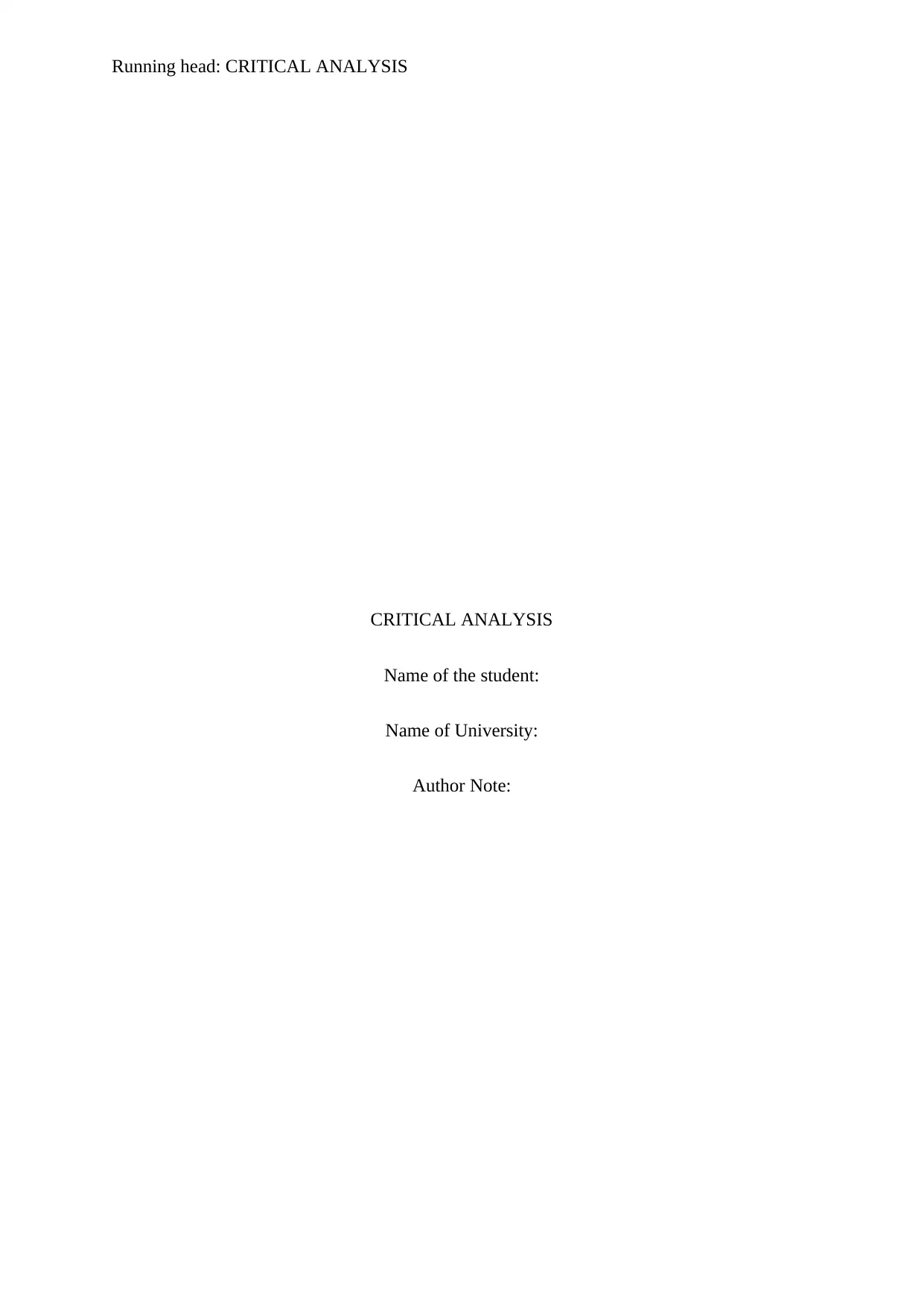
Running head: CRITICAL ANALYSIS
CRITICAL ANALYSIS
Name of the student:
Name of University:
Author Note:
CRITICAL ANALYSIS
Name of the student:
Name of University:
Author Note:
Secure Best Marks with AI Grader
Need help grading? Try our AI Grader for instant feedback on your assignments.
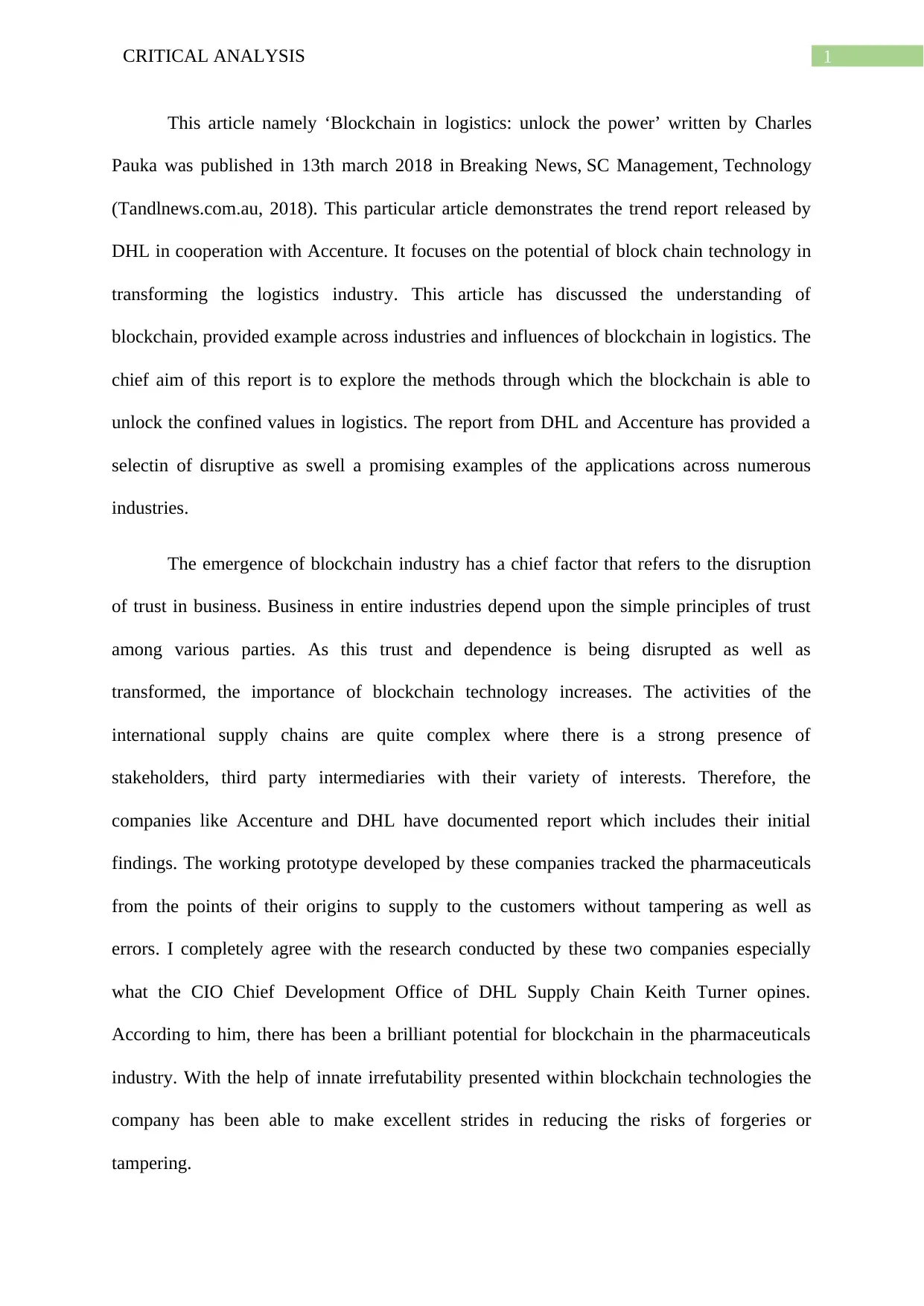
1CRITICAL ANALYSIS
This article namely ‘Blockchain in logistics: unlock the power’ written by Charles
Pauka was published in 13th march 2018 in Breaking News, SC Management, Technology
(Tandlnews.com.au, 2018). This particular article demonstrates the trend report released by
DHL in cooperation with Accenture. It focuses on the potential of block chain technology in
transforming the logistics industry. This article has discussed the understanding of
blockchain, provided example across industries and influences of blockchain in logistics. The
chief aim of this report is to explore the methods through which the blockchain is able to
unlock the confined values in logistics. The report from DHL and Accenture has provided a
selectin of disruptive as swell a promising examples of the applications across numerous
industries.
The emergence of blockchain industry has a chief factor that refers to the disruption
of trust in business. Business in entire industries depend upon the simple principles of trust
among various parties. As this trust and dependence is being disrupted as well as
transformed, the importance of blockchain technology increases. The activities of the
international supply chains are quite complex where there is a strong presence of
stakeholders, third party intermediaries with their variety of interests. Therefore, the
companies like Accenture and DHL have documented report which includes their initial
findings. The working prototype developed by these companies tracked the pharmaceuticals
from the points of their origins to supply to the customers without tampering as well as
errors. I completely agree with the research conducted by these two companies especially
what the CIO Chief Development Office of DHL Supply Chain Keith Turner opines.
According to him, there has been a brilliant potential for blockchain in the pharmaceuticals
industry. With the help of innate irrefutability presented within blockchain technologies the
company has been able to make excellent strides in reducing the risks of forgeries or
tampering.
This article namely ‘Blockchain in logistics: unlock the power’ written by Charles
Pauka was published in 13th march 2018 in Breaking News, SC Management, Technology
(Tandlnews.com.au, 2018). This particular article demonstrates the trend report released by
DHL in cooperation with Accenture. It focuses on the potential of block chain technology in
transforming the logistics industry. This article has discussed the understanding of
blockchain, provided example across industries and influences of blockchain in logistics. The
chief aim of this report is to explore the methods through which the blockchain is able to
unlock the confined values in logistics. The report from DHL and Accenture has provided a
selectin of disruptive as swell a promising examples of the applications across numerous
industries.
The emergence of blockchain industry has a chief factor that refers to the disruption
of trust in business. Business in entire industries depend upon the simple principles of trust
among various parties. As this trust and dependence is being disrupted as well as
transformed, the importance of blockchain technology increases. The activities of the
international supply chains are quite complex where there is a strong presence of
stakeholders, third party intermediaries with their variety of interests. Therefore, the
companies like Accenture and DHL have documented report which includes their initial
findings. The working prototype developed by these companies tracked the pharmaceuticals
from the points of their origins to supply to the customers without tampering as well as
errors. I completely agree with the research conducted by these two companies especially
what the CIO Chief Development Office of DHL Supply Chain Keith Turner opines.
According to him, there has been a brilliant potential for blockchain in the pharmaceuticals
industry. With the help of innate irrefutability presented within blockchain technologies the
company has been able to make excellent strides in reducing the risks of forgeries or
tampering.
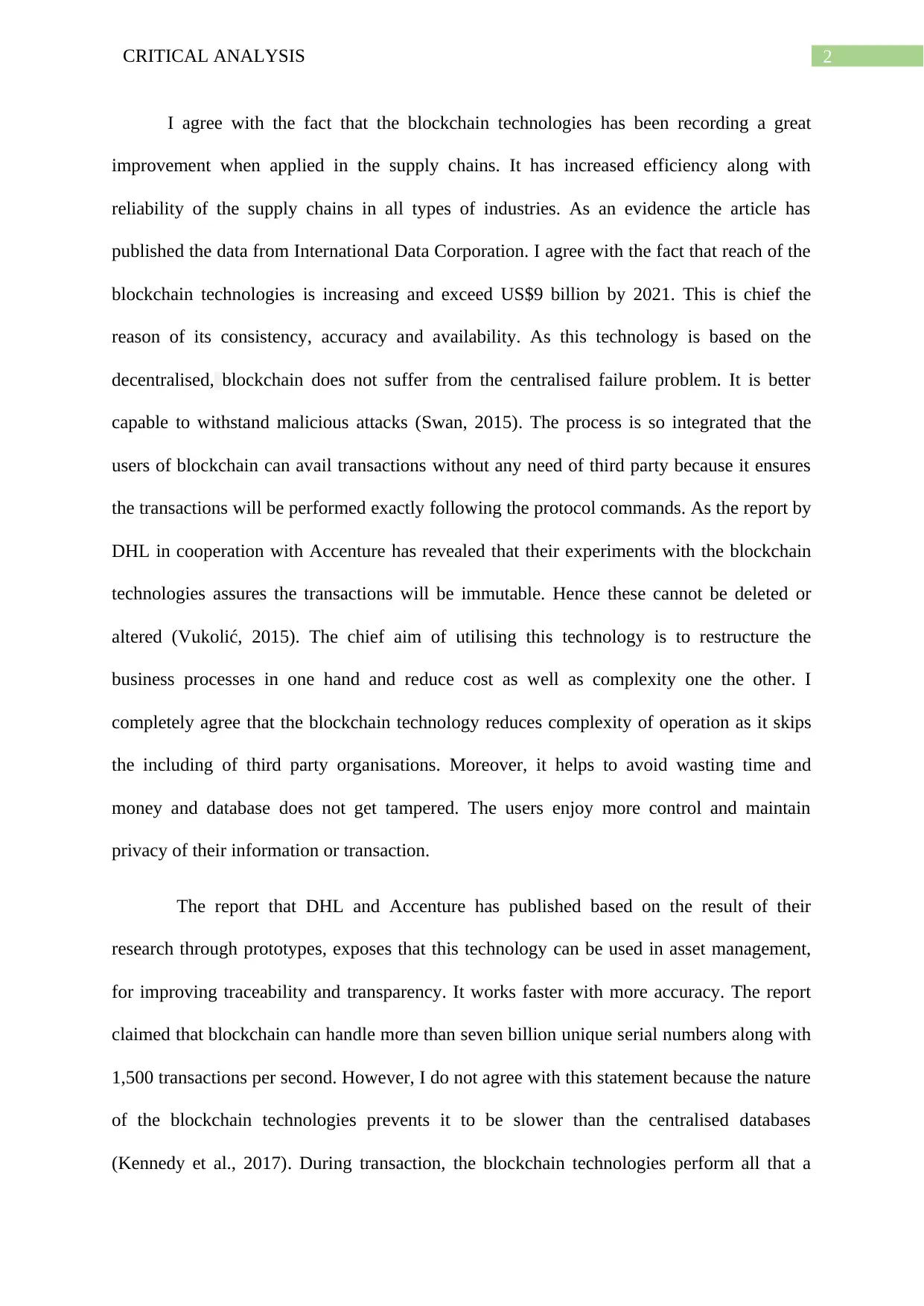
2CRITICAL ANALYSIS
I agree with the fact that the blockchain technologies has been recording a great
improvement when applied in the supply chains. It has increased efficiency along with
reliability of the supply chains in all types of industries. As an evidence the article has
published the data from International Data Corporation. I agree with the fact that reach of the
blockchain technologies is increasing and exceed US$9 billion by 2021. This is chief the
reason of its consistency, accuracy and availability. As this technology is based on the
decentralised, blockchain does not suffer from the centralised failure problem. It is better
capable to withstand malicious attacks (Swan, 2015). The process is so integrated that the
users of blockchain can avail transactions without any need of third party because it ensures
the transactions will be performed exactly following the protocol commands. As the report by
DHL in cooperation with Accenture has revealed that their experiments with the blockchain
technologies assures the transactions will be immutable. Hence these cannot be deleted or
altered (Vukolić, 2015). The chief aim of utilising this technology is to restructure the
business processes in one hand and reduce cost as well as complexity one the other. I
completely agree that the blockchain technology reduces complexity of operation as it skips
the including of third party organisations. Moreover, it helps to avoid wasting time and
money and database does not get tampered. The users enjoy more control and maintain
privacy of their information or transaction.
The report that DHL and Accenture has published based on the result of their
research through prototypes, exposes that this technology can be used in asset management,
for improving traceability and transparency. It works faster with more accuracy. The report
claimed that blockchain can handle more than seven billion unique serial numbers along with
1,500 transactions per second. However, I do not agree with this statement because the nature
of the blockchain technologies prevents it to be slower than the centralised databases
(Kennedy et al., 2017). During transaction, the blockchain technologies perform all that a
I agree with the fact that the blockchain technologies has been recording a great
improvement when applied in the supply chains. It has increased efficiency along with
reliability of the supply chains in all types of industries. As an evidence the article has
published the data from International Data Corporation. I agree with the fact that reach of the
blockchain technologies is increasing and exceed US$9 billion by 2021. This is chief the
reason of its consistency, accuracy and availability. As this technology is based on the
decentralised, blockchain does not suffer from the centralised failure problem. It is better
capable to withstand malicious attacks (Swan, 2015). The process is so integrated that the
users of blockchain can avail transactions without any need of third party because it ensures
the transactions will be performed exactly following the protocol commands. As the report by
DHL in cooperation with Accenture has revealed that their experiments with the blockchain
technologies assures the transactions will be immutable. Hence these cannot be deleted or
altered (Vukolić, 2015). The chief aim of utilising this technology is to restructure the
business processes in one hand and reduce cost as well as complexity one the other. I
completely agree that the blockchain technology reduces complexity of operation as it skips
the including of third party organisations. Moreover, it helps to avoid wasting time and
money and database does not get tampered. The users enjoy more control and maintain
privacy of their information or transaction.
The report that DHL and Accenture has published based on the result of their
research through prototypes, exposes that this technology can be used in asset management,
for improving traceability and transparency. It works faster with more accuracy. The report
claimed that blockchain can handle more than seven billion unique serial numbers along with
1,500 transactions per second. However, I do not agree with this statement because the nature
of the blockchain technologies prevents it to be slower than the centralised databases
(Kennedy et al., 2017). During transaction, the blockchain technologies perform all that a
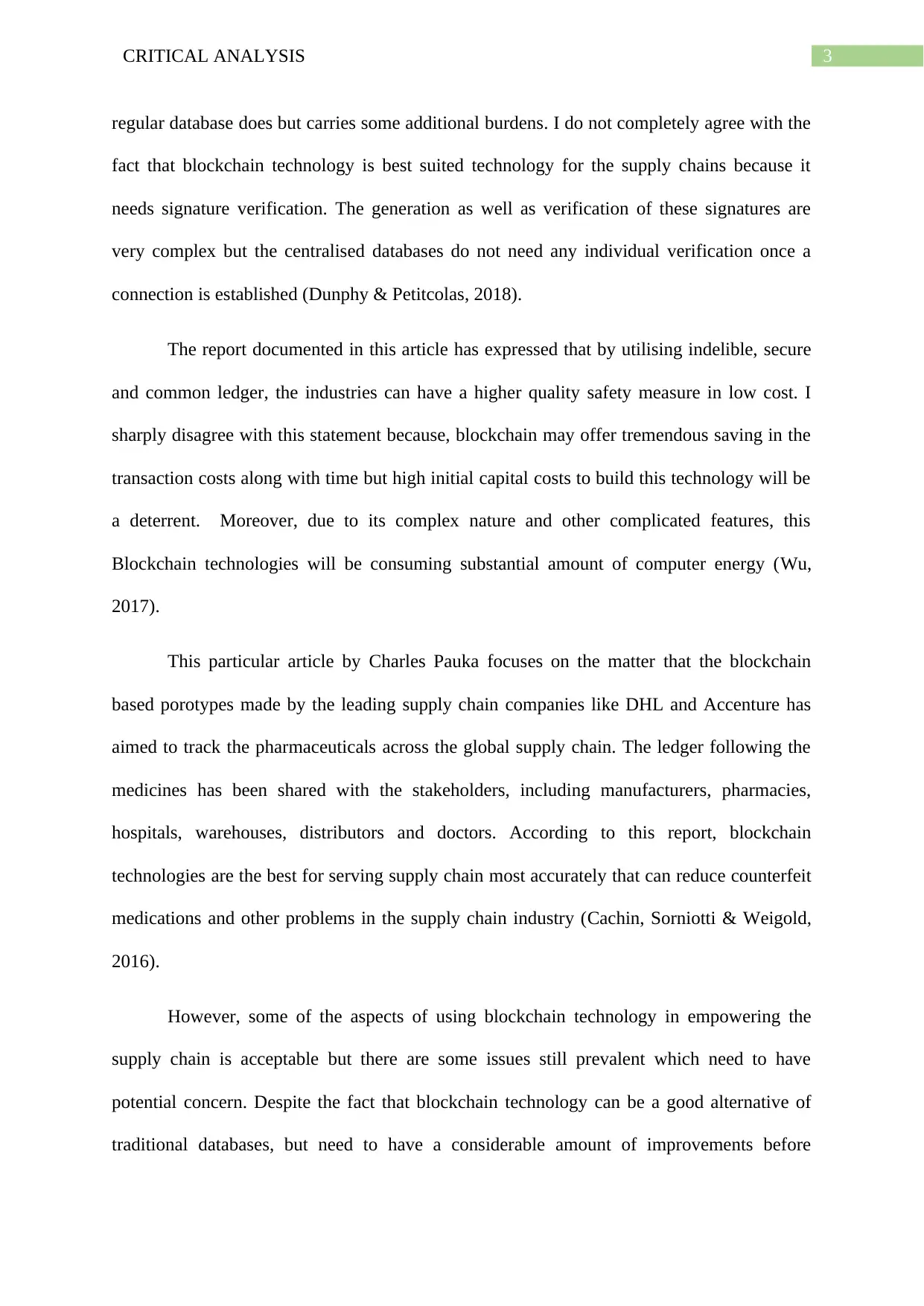
3CRITICAL ANALYSIS
regular database does but carries some additional burdens. I do not completely agree with the
fact that blockchain technology is best suited technology for the supply chains because it
needs signature verification. The generation as well as verification of these signatures are
very complex but the centralised databases do not need any individual verification once a
connection is established (Dunphy & Petitcolas, 2018).
The report documented in this article has expressed that by utilising indelible, secure
and common ledger, the industries can have a higher quality safety measure in low cost. I
sharply disagree with this statement because, blockchain may offer tremendous saving in the
transaction costs along with time but high initial capital costs to build this technology will be
a deterrent. Moreover, due to its complex nature and other complicated features, this
Blockchain technologies will be consuming substantial amount of computer energy (Wu,
2017).
This particular article by Charles Pauka focuses on the matter that the blockchain
based porotypes made by the leading supply chain companies like DHL and Accenture has
aimed to track the pharmaceuticals across the global supply chain. The ledger following the
medicines has been shared with the stakeholders, including manufacturers, pharmacies,
hospitals, warehouses, distributors and doctors. According to this report, blockchain
technologies are the best for serving supply chain most accurately that can reduce counterfeit
medications and other problems in the supply chain industry (Cachin, Sorniotti & Weigold,
2016).
However, some of the aspects of using blockchain technology in empowering the
supply chain is acceptable but there are some issues still prevalent which need to have
potential concern. Despite the fact that blockchain technology can be a good alternative of
traditional databases, but need to have a considerable amount of improvements before
regular database does but carries some additional burdens. I do not completely agree with the
fact that blockchain technology is best suited technology for the supply chains because it
needs signature verification. The generation as well as verification of these signatures are
very complex but the centralised databases do not need any individual verification once a
connection is established (Dunphy & Petitcolas, 2018).
The report documented in this article has expressed that by utilising indelible, secure
and common ledger, the industries can have a higher quality safety measure in low cost. I
sharply disagree with this statement because, blockchain may offer tremendous saving in the
transaction costs along with time but high initial capital costs to build this technology will be
a deterrent. Moreover, due to its complex nature and other complicated features, this
Blockchain technologies will be consuming substantial amount of computer energy (Wu,
2017).
This particular article by Charles Pauka focuses on the matter that the blockchain
based porotypes made by the leading supply chain companies like DHL and Accenture has
aimed to track the pharmaceuticals across the global supply chain. The ledger following the
medicines has been shared with the stakeholders, including manufacturers, pharmacies,
hospitals, warehouses, distributors and doctors. According to this report, blockchain
technologies are the best for serving supply chain most accurately that can reduce counterfeit
medications and other problems in the supply chain industry (Cachin, Sorniotti & Weigold,
2016).
However, some of the aspects of using blockchain technology in empowering the
supply chain is acceptable but there are some issues still prevalent which need to have
potential concern. Despite the fact that blockchain technology can be a good alternative of
traditional databases, but need to have a considerable amount of improvements before
Secure Best Marks with AI Grader
Need help grading? Try our AI Grader for instant feedback on your assignments.
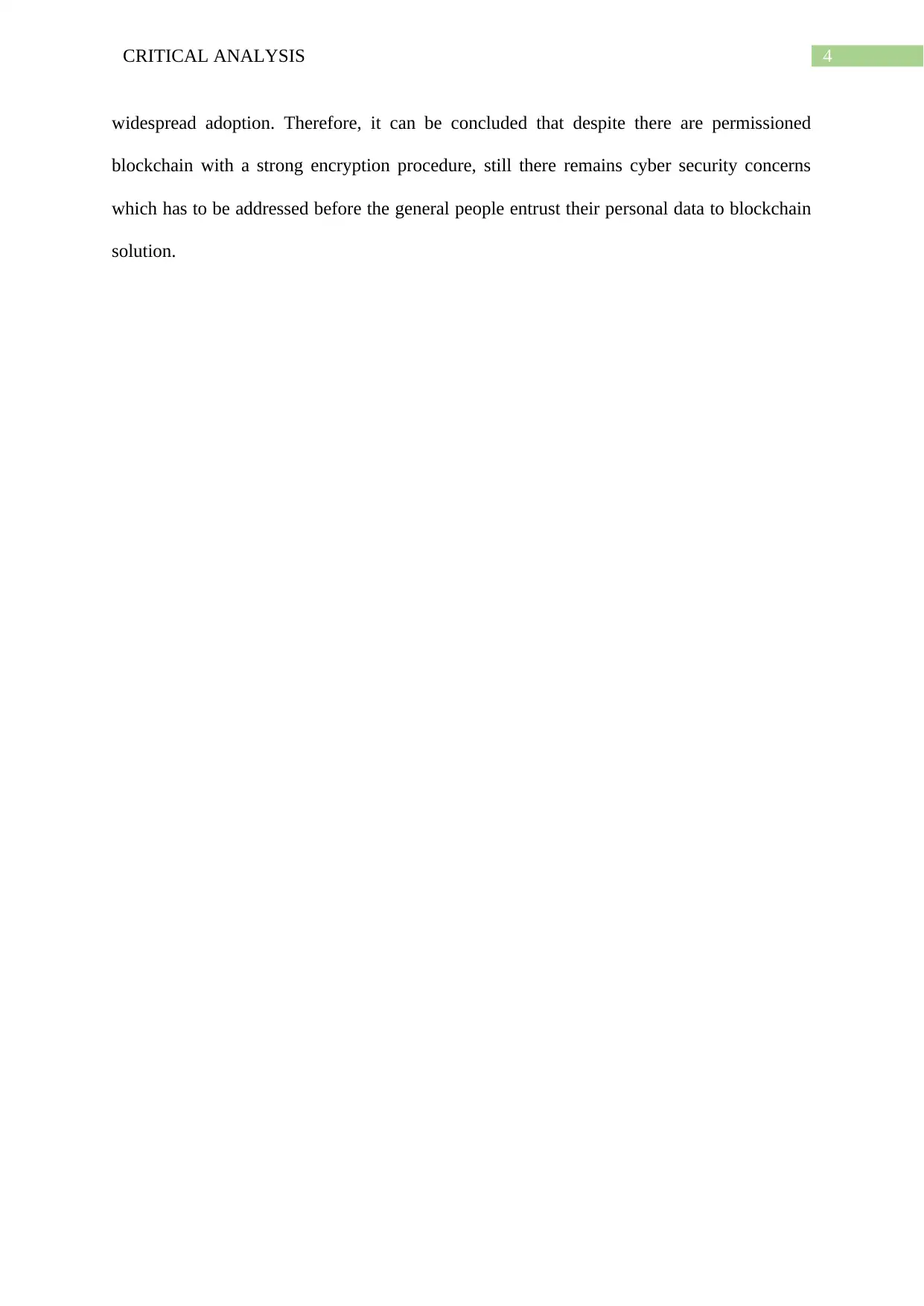
4CRITICAL ANALYSIS
widespread adoption. Therefore, it can be concluded that despite there are permissioned
blockchain with a strong encryption procedure, still there remains cyber security concerns
which has to be addressed before the general people entrust their personal data to blockchain
solution.
widespread adoption. Therefore, it can be concluded that despite there are permissioned
blockchain with a strong encryption procedure, still there remains cyber security concerns
which has to be addressed before the general people entrust their personal data to blockchain
solution.
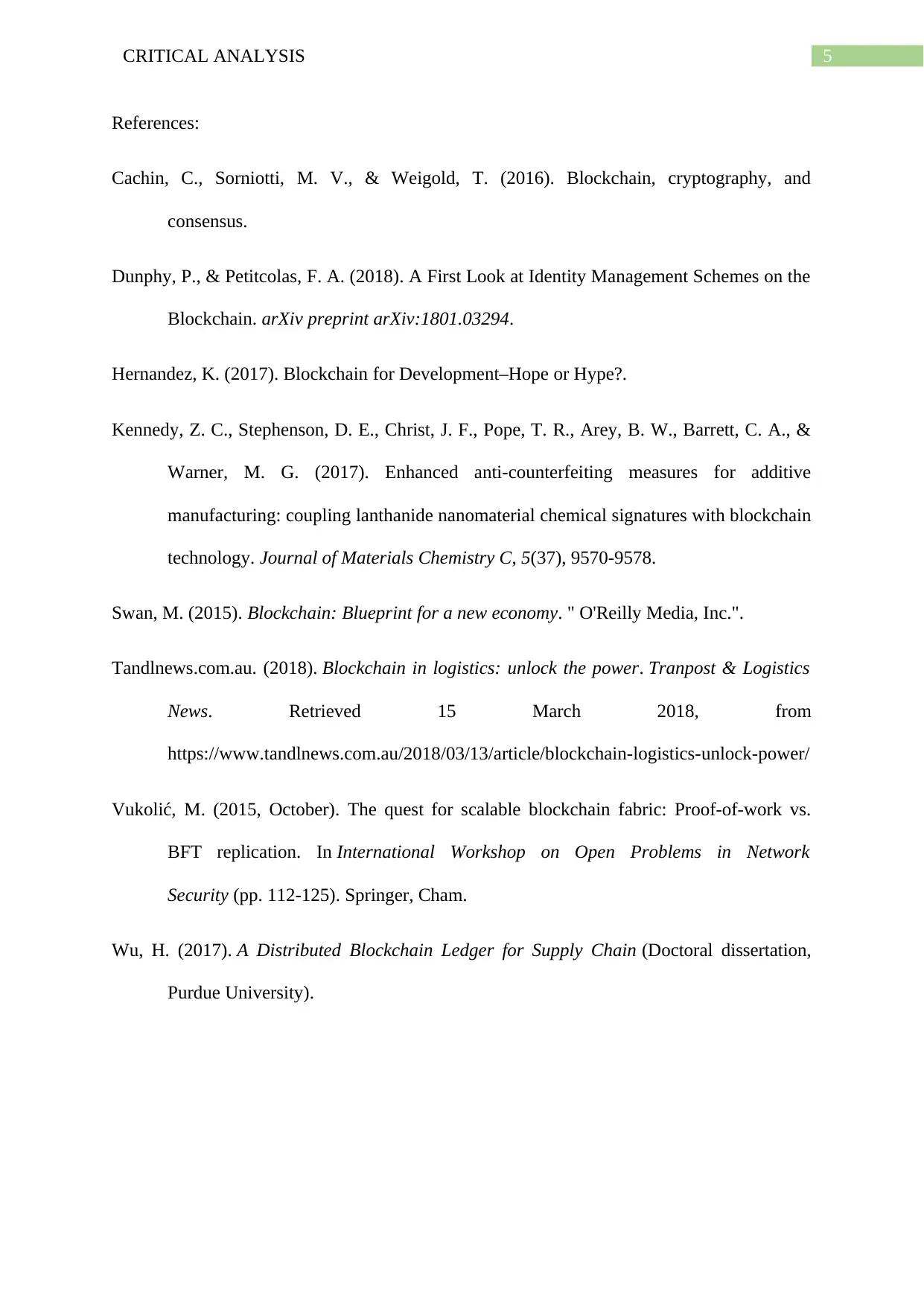
5CRITICAL ANALYSIS
References:
Cachin, C., Sorniotti, M. V., & Weigold, T. (2016). Blockchain, cryptography, and
consensus.
Dunphy, P., & Petitcolas, F. A. (2018). A First Look at Identity Management Schemes on the
Blockchain. arXiv preprint arXiv:1801.03294.
Hernandez, K. (2017). Blockchain for Development–Hope or Hype?.
Kennedy, Z. C., Stephenson, D. E., Christ, J. F., Pope, T. R., Arey, B. W., Barrett, C. A., &
Warner, M. G. (2017). Enhanced anti-counterfeiting measures for additive
manufacturing: coupling lanthanide nanomaterial chemical signatures with blockchain
technology. Journal of Materials Chemistry C, 5(37), 9570-9578.
Swan, M. (2015). Blockchain: Blueprint for a new economy. " O'Reilly Media, Inc.".
Tandlnews.com.au. (2018). Blockchain in logistics: unlock the power. Tranpost & Logistics
News. Retrieved 15 March 2018, from
https://www.tandlnews.com.au/2018/03/13/article/blockchain-logistics-unlock-power/
Vukolić, M. (2015, October). The quest for scalable blockchain fabric: Proof-of-work vs.
BFT replication. In International Workshop on Open Problems in Network
Security (pp. 112-125). Springer, Cham.
Wu, H. (2017). A Distributed Blockchain Ledger for Supply Chain (Doctoral dissertation,
Purdue University).
References:
Cachin, C., Sorniotti, M. V., & Weigold, T. (2016). Blockchain, cryptography, and
consensus.
Dunphy, P., & Petitcolas, F. A. (2018). A First Look at Identity Management Schemes on the
Blockchain. arXiv preprint arXiv:1801.03294.
Hernandez, K. (2017). Blockchain for Development–Hope or Hype?.
Kennedy, Z. C., Stephenson, D. E., Christ, J. F., Pope, T. R., Arey, B. W., Barrett, C. A., &
Warner, M. G. (2017). Enhanced anti-counterfeiting measures for additive
manufacturing: coupling lanthanide nanomaterial chemical signatures with blockchain
technology. Journal of Materials Chemistry C, 5(37), 9570-9578.
Swan, M. (2015). Blockchain: Blueprint for a new economy. " O'Reilly Media, Inc.".
Tandlnews.com.au. (2018). Blockchain in logistics: unlock the power. Tranpost & Logistics
News. Retrieved 15 March 2018, from
https://www.tandlnews.com.au/2018/03/13/article/blockchain-logistics-unlock-power/
Vukolić, M. (2015, October). The quest for scalable blockchain fabric: Proof-of-work vs.
BFT replication. In International Workshop on Open Problems in Network
Security (pp. 112-125). Springer, Cham.
Wu, H. (2017). A Distributed Blockchain Ledger for Supply Chain (Doctoral dissertation,
Purdue University).
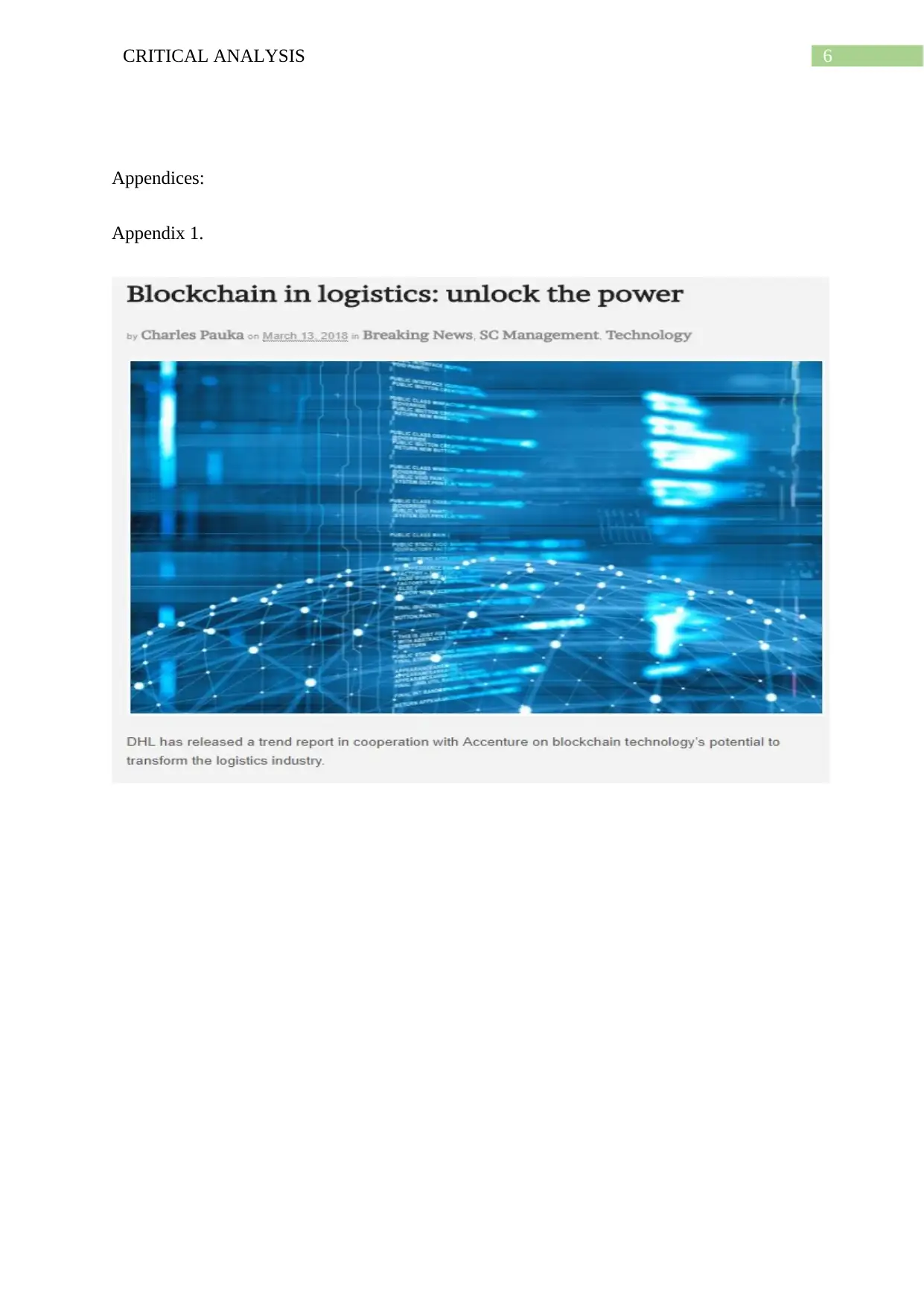
6CRITICAL ANALYSIS
Appendices:
Appendix 1.
Appendices:
Appendix 1.
Paraphrase This Document
Need a fresh take? Get an instant paraphrase of this document with our AI Paraphraser
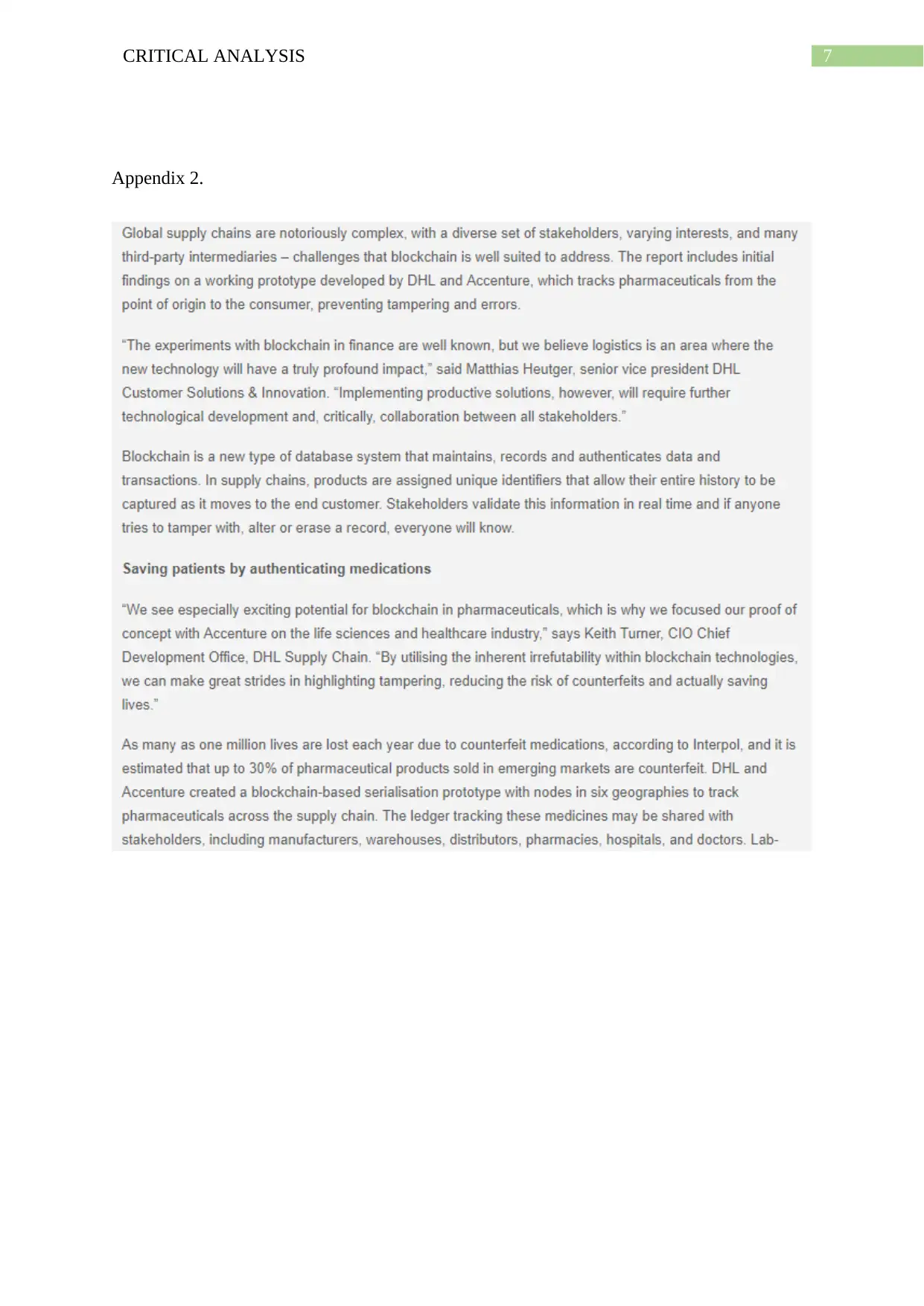
7CRITICAL ANALYSIS
Appendix 2.
Appendix 2.
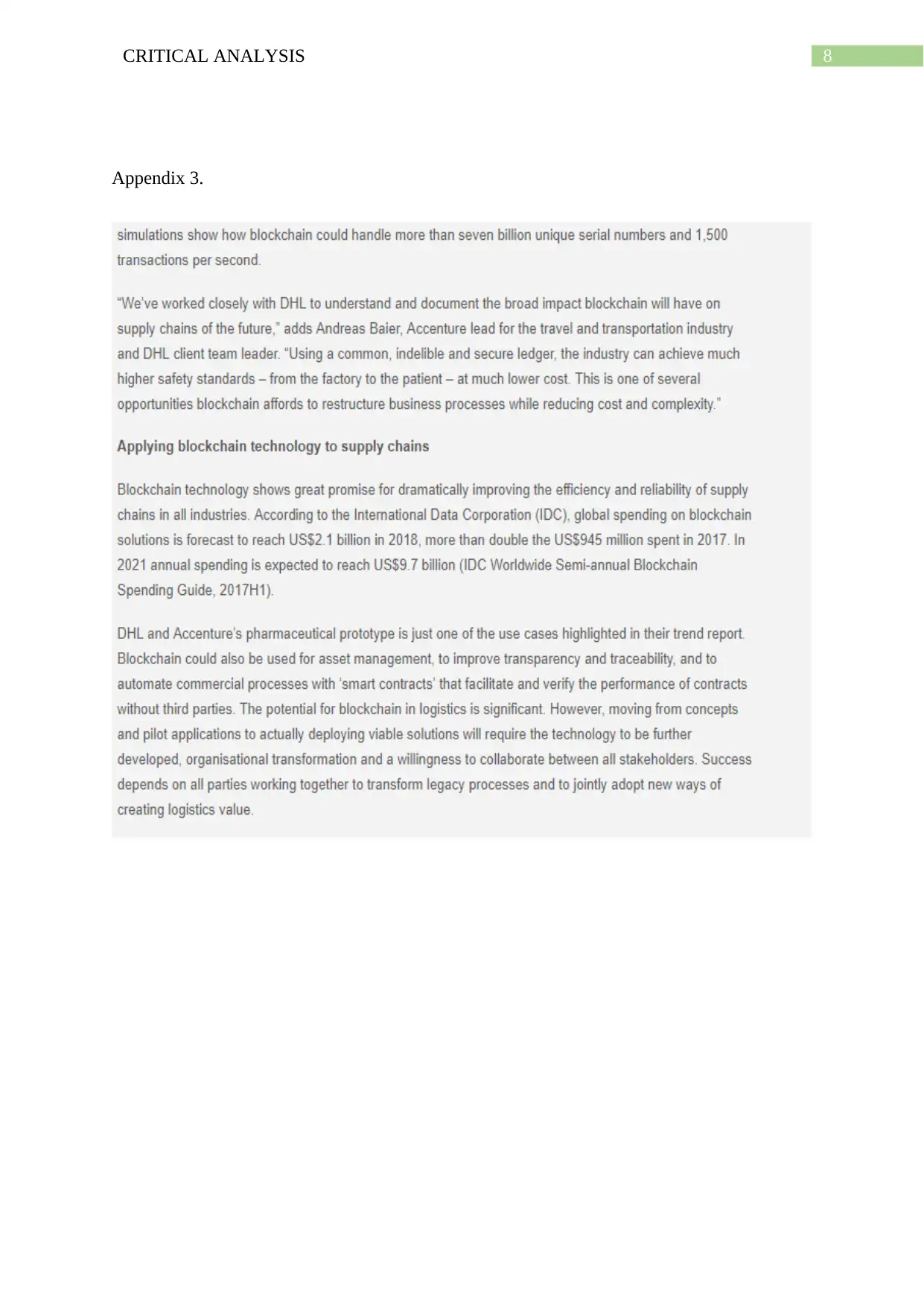
8CRITICAL ANALYSIS
Appendix 3.
Appendix 3.
1 out of 9
Your All-in-One AI-Powered Toolkit for Academic Success.
+13062052269
info@desklib.com
Available 24*7 on WhatsApp / Email
![[object Object]](/_next/static/media/star-bottom.7253800d.svg)
Unlock your academic potential
© 2024 | Zucol Services PVT LTD | All rights reserved.

